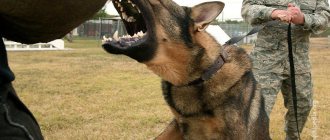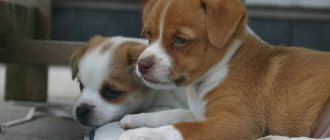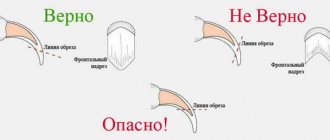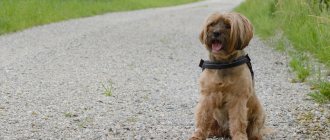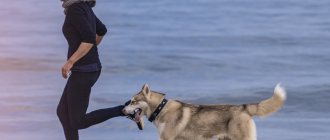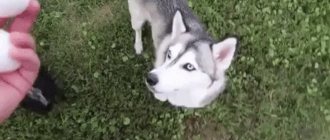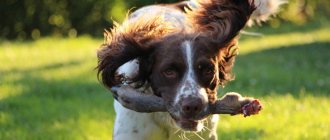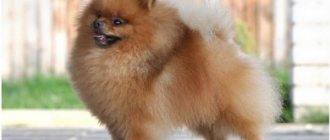Training is important not only for establishing contact with the owner, but also for maintaining basic order. A puppy that doesn't know its place will become a source of anxiety and will ultimately not recognize its owner's leadership. From the first days a pet appears in the house, it is important to know how to teach a dog the “Place!” command. This skill can be acquired by both an early-age animal and an adult pet. Naturally, before starting training, you should prepare a convenient and comfortable corner for relaxation. This material consistently reveals the topic of animal adaptation to new conditions.
How to teach your dog the command “Place!”
What is the "place" command used for?
As a rule, the “place” exercise is used in two cases: as a standard when passing a general training course and as a command for living comfortably with a pet at home.
For example, you have guests coming over or you are planning to cook, and you don’t want your pet getting under your feet to interfere with the process. In this case, the “place” command will be very useful to you.
In addition, any dog should have a corner, its own personal space, where it can calmly relax and unwind mentally.
It is very important that you or other family members do not touch the animal in its place. By doing this, you let the dog know that no one will touch him or give him undue attention when he wants to rest.
If the dog does not have such a place, he may begin to get stressed, because he simply will have nowhere to relax.
Compliance standards
A well-trained pet follows its owner's command at a distance of up to 15 meters and remains in place for up to 30 seconds. If such an order was given to him on the street, the dog should not pay attention to strangers or animals, get up prematurely, or run towards them without the owner’s permission.
When practiced correctly, the “Place” command should be performed from the person’s first word. The dog must obey the orders not only of its immediate owner, but also of other family members who walk with it on the street, feed the animal, and may visit the veterinary clinic with it.
Features of the OKD standard
As you already know earlier, the “place” command is also used for the purpose of passing a general training course. The everyday exercise and the “place” command in the OKD standard are different. How is the task performed in the OKD form?
The handler asks the dog to lie down, after which he places a thing in front of him (a bag, backpack or other object familiar to the animal), then gives the command “place”. After thirty seconds, the trainer calls the dog to him using the command “come to me.” The animal must remain in a sitting position for fifteen seconds, after which the “place” command is again given to it. The position of the dog near the object is taken into account: the distance of the animal from the object should not exceed one meter.
As soon as the dog has completed the “place” command, the trainer approaches him and asks the pet to sit down - at this stage the exercise ends.
How to teach a command to a dog older than 1 year
An adult dog is trained in the same way as a puppy, but the process may take a little longer. If you get an untrained adult dog, the methods are no different from the methods of training kids. Even if the animal is 5 or more years old, you need to start from the very first “puppy” level.
It is important to understand that training an adult dog will be more difficult than training a puppy. A mature pet needs more breaks and a little more freedom, especially if its previous life is unknown.
After the pet has mastered the basic skills, it is time to train him using jerk methods. With the help of treats, learning lasts longer. The fact is that a puppy is capable of a lot for the sake of a tasty piece, while an adult animal is able to appreciate the benefits.
The jerk method is harsher, but allows the dog to concentrate on following the command. Feeling the tugs, she will not try to escape or be distracted. That should be sharp: commands are carried out by running. If the exercise is not completed completely, it should not be rewarded.
Choice of treats
Reward plays a significant role in training - it gives the animal motivation. It is very important to choose the right treat for your pet.
Each dog is individual and has its own characteristics, including taste preferences.
That is why, unfortunately, there is no single treat for all animals. Some people like chicken, while others prefer liver. Some four-legged animals will happily work for pieces of vegetables!
If you think that your dog is very picky and is not interested in any food, then you have not done a good job in choosing treats. Maybe your dog will be ready to sell his soul for cottage cheese?
Try offering your pet more options for treats. Observe which ones your dog likes the most. Supermarkets have a huge selection of meat by-products: hearts, lungs, liver, kidneys, stomachs, udders.
For classes, it is better to cook meat products, solely for your convenience. But if it’s not important to you, and the dog prefers raw meat, then please reward your pet with raw products.
Attention! Your pet may be allergic to certain types of foods. Be sure to monitor his body’s reaction and consult a specialist.
Rewards for training
When choosing a treat, you need to choose a product that will be most desirable for a puppy or adult dog. This way you can achieve maximum results from your training. You can refer to the following list:
Table 2. Tasty rewards
| Name | Advantages of using it as a treat | Disadvantages of use |
| Cheese | Does not form crumbs, is convenient, the dog swallows the pieces easily | An increased level of thirst, if the cheese contains salt, can cause allergic reactions and gastrointestinal disorders |
| Chicken meat, including fillet, heart, gizzards | A protein product containing amino acids necessary for the animal's body. | The heart puts a strain on the gastrointestinal tract; chicken liver can negatively affect the functioning of the stomach. The fillet is inconvenient because it forms crumbs |
| Sausages | Ease of use and storage | The composition may contain components that cause allergies or gastrointestinal disorders (spices, preservatives, etc.) |
| Dry food | No need to worry about storage and heat treatment, convenient size | The animal may choke or feel thirsty if used in large quantities. |
The list of prohibited elements of the diet for training includes sweets, including sweets and chocolate.
The selection of products for promotion is carried out individually
When the dog and the owner, during joint exercises, have decided which treat is most desirable for it, you should make sure that it receives it correctly:
- The size of the piece should not be more than half a centimeter. During the training, the child is not fed, but trained to perform certain actions. In addition, small portions are easy to swallow.
- The treat should not make a particular pet feel thirsty. Otherwise, instead of training, the dog will think about drinking.
- The tasty morsel should be more attractive to the animal than the types of food it receives in its normal daily diet.
The owner must take care of a container for storing and carrying treats. This could be a small bag or wallet that attaches to a belt, a hip bag, etc.
Properly cut treats are easy to give to your dog.
Here's how to offer your dog a treat:
- An open palm is extended to her, like a horse. This keeps the animal from biting and will not allow it to grab a finger or other part of the hand. If this measure does not help, you should first put on a glove.
- The second option, which is used when teaching a skill, is to force the animal to hunt for prey for a while. In this case, the hand is raised to such a level that the dog can reach it from the stand on its hind legs, or jump to it.
- During training, a static position is used, when the treat is placed directly in the mouth. This is necessary so that the dog remains in place and does not move.
If the animal is bored, you can use play reinforcement instead of food.
If your pet prefers fun games to food, you can use them as a way to relieve stress and praise him for doing the exercises correctly. The first option is to play with a ball, the size of which should be large enough so that the dog does not choke. You can throw a toy, encouraging him to bring it back. You can let your pet chase a ball or use a ball on a string. The second option is to purchase a tug toy at a pet store, with which the dog can not only have fun, but also compete with the owner (within certain limits). Instead of a finished toy, you can use fabric or rope. One way or another, the owner needs to be able to control the dog’s will and emotions so that the game does not turn into a real fight.
You can switch your pet's attention to his favorite toy
In order for your pet’s favorite toys to have value for them, they need to be given out only during classes. Otherwise they will not motivate.
Selecting a location
The bed, first of all, should be located in a place that is comfortable for the dog. Ideally, this is a quiet and remote corner.
The place should not be located in a corridor or room where there are almost always a lot of people. Eliminate noise sources near the bed, as well as all possible factors that could cause stress in the animal. There should be no draft in the place.
Arrangement of the place
Choose a soft bed on which the dog can easily lie down. If the place is on a cold concrete floor, prefer a lounger with a thick tray.
What is needed to teach the “down” command?
Shepherd dog on exposure
The first training with the puppy begins at home. In warm weather, if you have the necessary vaccinations, training can begin outside. Just choose a clean place so that dogs don’t really like to lie down on a damp or dirty surface, and puppies even more so.
So, the trainer will need:
- Delicacy.
- Toy.
- Good mood.
- A quiet place with a minimum of irritants.
Going outside always starts with satisfying the puppy or dog's natural needs. Only after this can you begin training.
Ways to train a puppy and an adult dog
There is no difference between training a puppy and an adult dog. The methods apply the same to everyone. The only thing is that there are differences between the duration of the approaches:
- A puppy under 4 months should be trained in short approaches, starting with a minute and ending with three minutes. Gradually increase the time of approaches, do not start training immediately with a five-minute lesson. Do several of these throughout the day.
- An older puppy should also be trained, starting with short approaches. Here you can increase the time slightly, gradually arriving at a 10-minute session. Don't forget to take breaks between sets. You can exercise your puppy in the morning, lunch and evening. The main thing is not to stretch out your classes for too long.
- With an adult dog, start training as you would with a puppy, with two-minute approaches. A pet cannot be fed with long, same type of training. Especially if the animal is not yet accustomed to training. Gradually, you can move up to a fifteen-minute lesson. Don't forget to take breaks. You can play with your dog during the training process - this will prevent the animal from overloading its brain.
Method 1
Sit next to the lounger. It is better to be at approximately the same height as the animal to make it more comfortable. Use treats to draw your pet's attention to you. Extend your hand with food to the dog’s nose and smoothly point it towards the bed.
If the animal does not follow the hand with a treat well, first give the treat a few steps away, gradually requiring the dog to come closer to the bed. As soon as your pet puts at least one paw on the bed, immediately reward him.
Next, ask the dog to put up several paws, and then all four. As soon as your pet confidently climbs onto the bed, remove your hand away from his nose, giving the animal the opportunity to enter the place on his own.
Remove your hand not abruptly, but gradually, turning it into a gesture.
After the dog understands what you require from it, you can smoothly move away from the bed. First, take a step back, increasing the distance to several meters.
If at some point the pet gets lost and is unable to enter the place on its own, return to the stage below, reducing the distance and expressing the command with a clearer gesture.
As soon as you see that the dog is confidently completing the task, enter the voice command “place”. Keep in mind that your pet should not leave the place without your permission.
The end result will be that the pet will go to the place at your command from another room.
Method 2
This method is called "shaping". It takes longer, but with its help the dog learns to think and offer different options for executing the command.
Grab a treat and sit next to the spot. Let your dog sniff your hand with the treat, but do not give it to your pet. The dog will try to take the treat, run around you, or even bark.
You don't have to react to incorrect behavior, just wait. As soon as your pet even looks in the direction of the lounger, give him a treat.
Repeat this several times, then increase the criteria. This means that now the look of the dog on the lounger is not enough for you.
You now need the pet to take a step towards the place. As soon as he does this, praise your pet thoroughly.
Gradually, require the dog to take more steps towards the bed until the dog begins to step on it. First praise the dog if he steps on one spot with one paw, then for two, three and four.
Repeat this several times, after which you can enter the gesture. If the dog confidently enters the bed, gradually begin to move away from it - first one step, increasing the distance to several meters. Enter the voice command "place".
After your pet has clearly mastered the skill, you can begin to ensure that on your command the dog goes to the place from another room.
Weaning off sofas, beds and armchairs
The hardest thing is to train animals that are accustomed to sleeping on the owner’s furniture. Here it is important to adhere to cohesion among household members and mandatory punishment for disobedience.
If you notice an attack on your bed, say loudly “No” and take the dog to its bed. If she rushes back, repeat the ban and lightly press her to the floor, demonstrating your leadership. Repeat these steps until you see results.
IMPORTANT!
If you are against sleeping together, then never violate the established ban. Otherwise, you will undermine your authority in the eyes of the dog.
Possible mistakes
- Working with a leash. Do not try to attach a leash and drag the dog into place by it. Even if you are already working with treats. Jerking will not help the pet learn the exercise, but will only spoil the dog’s attitude towards training and towards you.
- Too many treats for one reinforcer. In order for your dog to be willing to contact you, do not give him a mountain of treats at once. Encourage your pet often, but little, otherwise he will quickly get full and will not be interested in the training process.
- Abrupt transitions from one stage to the next. Always move to new steps in learning smoothly and gradually. If you dramatically complicate the dog’s task, for example, almost immediately trying to send the animal to its place from another room, the pet simply will not understand what they want from it.
- Constant help for your pet. If the dog, after he has succeeded in executing the command “place” several times, begins to offer other options that are unnecessary to you, do not immediately point him to the bed with a treat. Give your pet the opportunity to think, don’t do everything for him. Keep in mind that if the dog fulfilled your request incorrectly more than three times, your help in guiding him to the spot with a treat is already important.
Summarizing
Teaching a dog the “Place” command is not as simple as it might seem at first glance. The animal must be aware of why it needs to carry out this command and for what reason. For example, if a dog behaves badly, shows aggression towards other animals, and does not do what the owner says, then this command will be appropriate. But not everyone uses this command as punishment. Many owners say to the dog: “Place” when they need to leave the pet, for example, near the store.
In any case, under whatever circumstances you use the “Place” command, you should remember that you need to pronounce it without aggression, in a calm voice, so as not to offend or frighten the dog, and especially a small puppy. If you understand that you cannot cope with training your pet on your own, then you can turn to dog trainers.
Experienced specialists with many years of experience in this field will quickly be able to teach your pet all the necessary commands in the shortest possible period of time. Therefore, trusting professionals is an excellent solution for every caring owner.
Briefly about the main thing
- Choose a quiet, secluded place in the house where you will place the lounger. The place should be soft and pleasant for the dog.
- Train your pet, starting with small approaches of a few minutes. Gradually, you can move on to longer sets. Don't overdo it with training.
- Use treats to guide your pet towards the bed. First, reward your dog for the smallest actions in the right direction. Next, you can gradually increase the criteria and demand more from your pet.
- Train your dog gradually, without moving to a new stage too abruptly, and also reward the dog with treats often, but little. Also, allow the dog to think during the training process, do not do everything for him, returning to the previous stage immediately after the first unsuccessful attempt. Forget about using a leash.
We hope that thanks to our tips, your four-legged animals will easily learn the “place” command. You can share your opinion about the article or ask a question, we will be happy to answer you! We wish you and your tailed good luck!
Did you like the article? Share it with your friends on social media. networks. This will help them get useful information and support our project.
At what age should a puppy be taught his place?
You need to start training immediately after the baby moves into your home, that is, at 2-3 months. After getting acquainted with new smells and unusual surroundings, the new resident needs to be fed and taken to a pre-prepared corner.
Don't delay with the toilet either. Tired of games and a hearty lunch, the puppy will most likely want to relieve itself. To avoid an incident, first of all you should put him on a diaper and only then take him to the lounger. Otherwise, there is a risk that the last one will be mistaken for a toilet.
A few words about a tougher approach to practicing this command.
Of course, it is possible to start learning this skill right away with harsh coercion. In this case, such coercion is necessary so that the dog forgets about other interests. The main thing she should think about is what needs to be done to avoid pressure and correction. The trainer must technically work in such a way that the dog very quickly understands that correction can only be avoided by lying still, that is where the saving comfort zone is, there is no other way out. An ordinary dog owner cannot do this; he is not ready to work like that. Since the dog is a family member for him, and not an object of influence.
What should you do first?
Give the puppy a place in a cozy corner, if possible not in the aisle, away from heating appliances, not in the kitchen or on the balcony. It is quite understandable that sometimes it is not possible to fulfill all these requirements, nevertheless, try to create some semblance of comfort for the puppy.
As a place for the dog, you can simply use a bedding or rug, a mattress, a dog bed, a special bed for dogs, or a lightweight foam booth covered with durable fabric. You should not immediately purchase expensive mattresses or bedding, since the puppy may not always like them. Manufacturers of pet products offer a wide range of different options for dog resting places, from which you will surely be able to choose something that suits you. It is clear that you need to focus on the future size of the dog, but first, a place to rest, even if in the future the puppy grows into a large dog, you need to choose based on the current size of the puppy with a reserve of 3-4 months - later you will need a bedding, rug or bed change to a larger one.
Method two - with hooking
If we are talking about an obstinate adult dog, and you prefer harsher methods, you can try the hooking method. In this case, you need to put your left hand on your pet's withers, and with the other hand grab it under the front paws. Then press with your right hand on the withers, tap a little (this is called sweeping). The dog must lie down; praise her. Let it remain in this position for 5-10 seconds, then the animal must be released. Do not release the dog immediately and do not hold it in this position for too long.
It is very important to help the dog take the correct position - the body should be straight, without falling, and the front legs should be extended.
How to teach a puppy the command “give me your paw”
After mastering the most necessary commands, you can begin training everyone’s favorite command, “give me your paw.” Princes is very, very simple, and you can watch the video below to teach a puppy the give paw command. We take a treat in one hand, show it to the baby, with the other hand we take his paw saying “give me a paw”, after praising him, we give him a treat. Having repeated this exercise many times, the puppy will remember exactly what is required of him.
In addition, many pets, after learning this command, themselves take the initiative, approaching the owner and offering a paw. So the dog seems to say “feed me, otherwise I’m hungry.”
Video instruction: how to teach a puppy the command give paw
Where to place the dog place?
In how to accustom a dog to a place, the placement of the mattress in the apartment also plays an important role. You cannot force a small puppy to be in drafts, on passages, or in noisy rooms. The dog will still leave there. Thus, difficulties will arise in training the animal.
The location in the room for a dog house or mattress should be away from heating systems, climate control units, and sources of noise or vibration. The puppy’s personal nest should not be placed where children like to play or where any household appliances or equipment, such as a computer or refrigerator, are constantly running. There is no need to arrange a dog's home in the kitchen.
